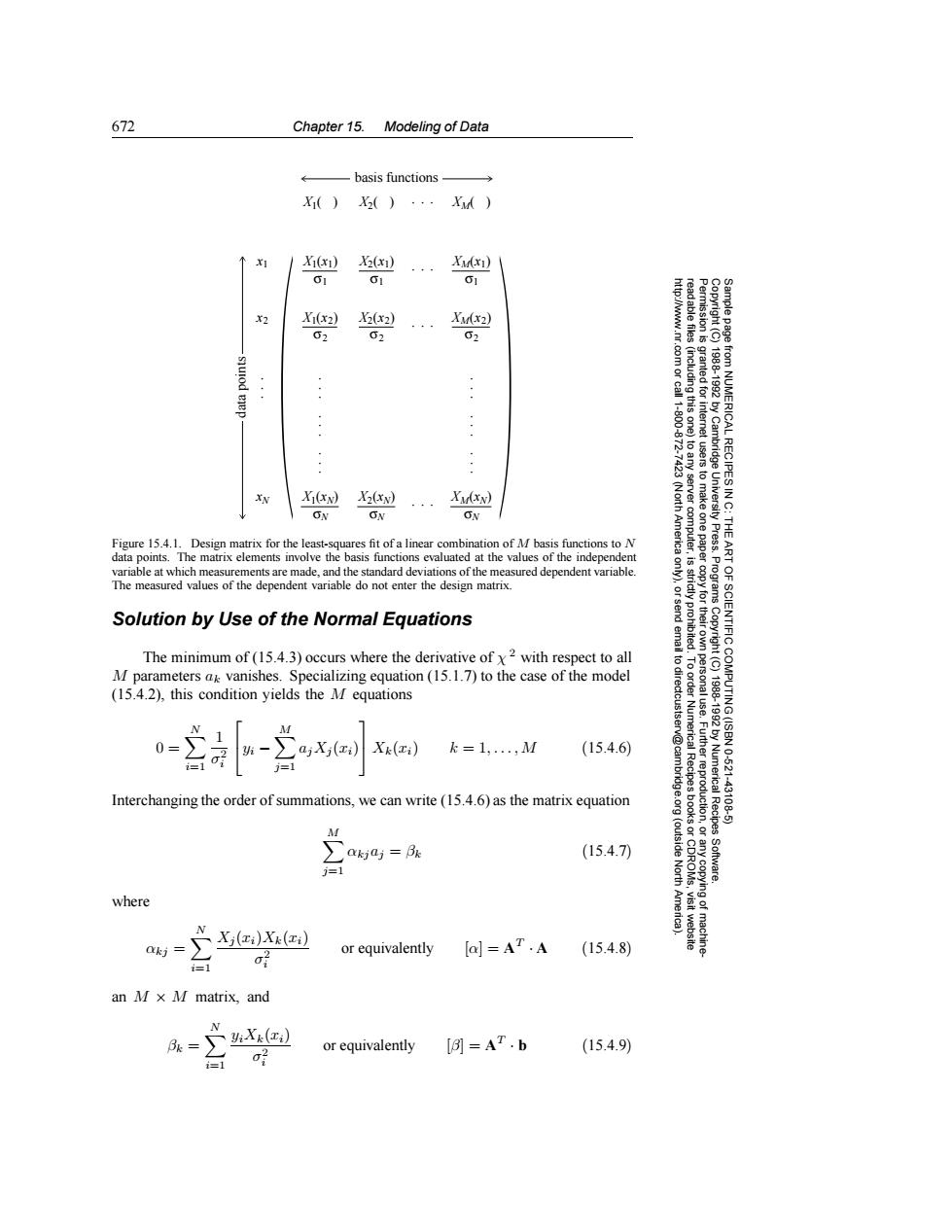正在加载图片...

672 Chapter 15.Modeling of Data basis functions- X()X()···X) 1 X(x1) X3(x) XM(x1) 01 01 01 X2 X(x2) X(x2) XM(x2) 02 02 61 Permission is read able files Sample page : .. Xi(N) X(IN) XM(XN) http://www.nr.com or call 1-800-872-7423(North America (including this one)to any server computer, granted for interet users to make one paper Copyright (C)1988-1992 by Cambridge University Press. from NUMERICAL RECIPES IN C: ON ON Figure 15.4.1.Design matrix for the least-squares fit of a linear combination of M basis functions to N data points.The matrix elements involve the basis functions evaluated at the values of the independent variable at which measurements are made,and the standard deviations of the measured dependent variable. 是 The measured values of the dependent variable do not enter the design matrix. Programs Solution by Use of the Normal Equations copy for their The minimum of(15.4.3)occurs where the derivative ofx2 with respect to all M parameters ak vanishes.Specializing equation(15.1.7)to the case of the model to dir Copyright(C) (15.4.2),this condition yields the M equations 1788-1982 THE ART OF SCIENTIFIC COMPUTING(ISBN 0-521 N 0= Xk(zi) k=1,M (15.4.6) Interchanging the order of summations,we can write(15.4.6)as the matrix equation .Further reproduction, Numerical Recipes -43108-5 M (15.4.7) (outside j=1 Software. where Amer N Xj(zi)Xk(zi) ying of machine visit website akj= or equivalently [a]=AT.A (15.4.8) i=1 0 an M x M matrix,and A=∑ w or equivalently [31=AT.b (15.4.9) =1672 Chapter 15. Modeling of Data Permission is granted for internet users to make one paper copy for their own personal use. Further reproduction, or any copyin Copyright (C) 1988-1992 by Cambridge University Press. Programs Copyright (C) 1988-1992 by Numerical Recipes Software. Sample page from NUMERICAL RECIPES IN C: THE ART OF SCIENTIFIC COMPUTING (ISBN 0-521-43108-5) g of machinereadable files (including this one) to any server computer, is strictly prohibited. To order Numerical Recipes books or CDROMs, visit website http://www.nr.com or call 1-800-872-7423 (North America only), or send email to directcustserv@cambridge.org (outside North America). X1(x1) σ1 x1 X2(x1) σ1 . . . XM(x1) σ1 X1( ) X2( ) . . . XM( ) X1(x2) σ2 x2 X2(x2) σ2 . . . XM(x2) σ2 . . . . . . . . . . . . . . . . . . . . . X1(xN) σN xN X2(xN) σN . . . XM(xN) σN data points basis functions Figure 15.4.1. Design matrix for the least-squares fit of a linear combination of M basis functions to N data points. The matrix elements involve the basis functions evaluated at the values of the independent variable at which measurements are made, and the standard deviations of the measured dependent variable. The measured values of the dependent variable do not enter the design matrix. Solution by Use of the Normal Equations The minimum of (15.4.3) occurs where the derivative of χ2 with respect to all M parameters ak vanishes. Specializing equation (15.1.7) to the case of the model (15.4.2), this condition yields the M equations 0 = N i=1 1 σ2 i yi − M j=1 ajXj (xi) Xk(xi) k = 1,...,M (15.4.6) Interchanging the order of summations, we can write (15.4.6) as the matrix equation M j=1 αkjaj = βk (15.4.7) where αkj = N i=1 Xj(xi)Xk(xi) σ2 i or equivalently [α] = AT · A (15.4.8) an M × M matrix, and βk = N i=1 yiXk(xi) σ2 i or equivalently [β] = AT · b (15.4.9)